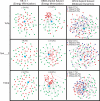Solvent dramatically affects protein structure refinement
- PMID: 19073921
- PMCID: PMC2600579
- DOI: 10.1073/pnas.0810818105
Solvent dramatically affects protein structure refinement
Abstract
One of the most challenging problems in protein structure prediction is improvement of homology models (structures within 1-3 A C(alpha) rmsd of the native structure), also known as the protein structure refinement problem. It has been shown that improvement could be achieved using in vacuo energy minimization with molecular mechanics and statistically derived continuously differentiable hybrid knowledge-based (KB) potential functions. Globular proteins, however, fold and function in aqueous solution in vivo and in vitro. In this work, we study the role of solvent in protein structure refinement. Molecular dynamics in explicit solvent and energy minimization in both explicit and implicit solvent were performed on a set of 75 native proteins to test the various energy potentials. A more stringent test for refinement was performed on 729 near-native decoys for each native protein. We use a powerfully convergent energy minimization method to show that implicit solvent (GBSA) provides greater improvement for some proteins than the KB potential: 24 of 75 proteins showing an average improvement of >20% in C(alpha) rmsd from the native structure with GBSA, compared to just 7 proteins with KB. Molecular dynamics in explicit solvent moved the structures further away from their native conformation than the initial, unrefined decoys. Implicit solvent gives rise to a deep, smooth potential energy attractor basin that pulls toward the native structure.
Conflict of interest statement
The authors declare no conflict of interest.
Figures





References
-
- Lattman E. The state of the Protein Structure Initiative. Proteins. 2004;54:611–615. - PubMed
-
- Service RF. Protein Structure Initiative: Phase 3 or phase out. Science. 2008;319:1610–1613. - PubMed
-
- Baker D, Sali A. Protein structure prediction and structural genomics. Science. 2001;294:93–96. - PubMed
-
- Arakaki AK, Zhang Y, Skolnick J. Large-scale assessment of the utility of low-resolution protein structures for biochemical function assignment. Bioinformatics. 2004;20:1087–1096. - PubMed
-
- Wieman H, Tøndel K, Anderssen E, Drabløs F. Homology-based modelling of targets for rational drug design. Mini Rev Med Chem. 2004;4:793–804. - PubMed
Publication types
MeSH terms
Substances
Grants and funding
LinkOut - more resources
Full Text Sources

